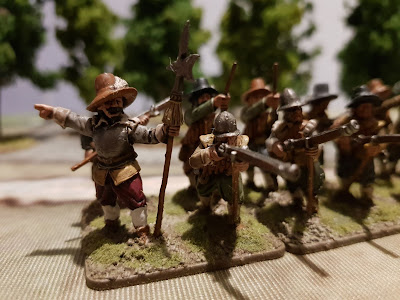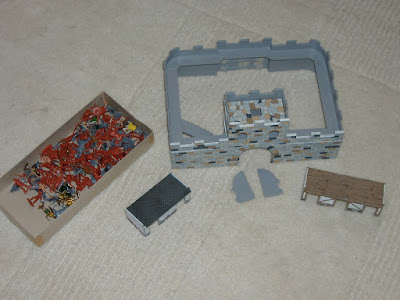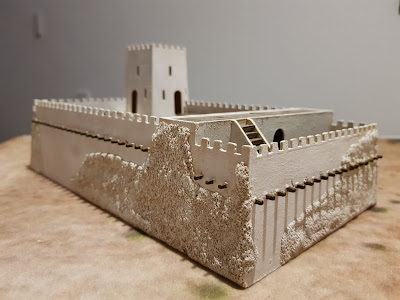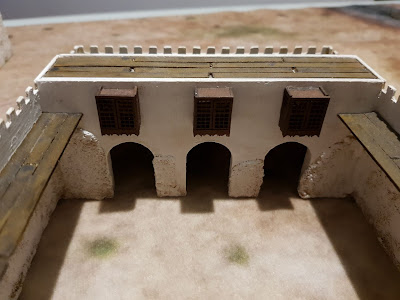Heute
geht es erneut in den Dreißigjährigen Krieg, wie bereits in meinem Spielbericht
vor ein paar Wochen.
Sie erinnern sich? Wenn nicht anbei der Link:
Geschichte als Hobby: Sehen - Lesen - Spielen: Pikeman's Lament - Ga Pa (thrifles.blogspot.com)
Nun ist es allerdings so, dass zwischen dem damaligen Bericht und dem heutigen Tag doch einiges passiert ist.
Damals hatte ich ja noch Figuren von Sven in die Schlacht geführt. Heute kann ich Ihnen meine eigene Truppe für Pikeman’s lament vorstellen.
Dabei stellen die Einheiten, die ich Ihnen jetzt zeige, nur einen Teil eines Gesamtprojektes dar.
Mittlerweile konnte ich das Figurenprojekt 30jähriger Krieg für mich persönlich abschließen.
Die gesamte Truppe werde ich Ihnen demnächst genauer vorstellen.
Hier im Bericht sehen sie eine Pikeman’s lament konforme 24 Punkte Einheit, die Truppen der katholischen Seite darstellen soll.
Sie erinnern sich? Wenn nicht anbei der Link:
Geschichte als Hobby: Sehen - Lesen - Spielen: Pikeman's Lament - Ga Pa (thrifles.blogspot.com)
Nun ist es allerdings so, dass zwischen dem damaligen Bericht und dem heutigen Tag doch einiges passiert ist.
Damals hatte ich ja noch Figuren von Sven in die Schlacht geführt. Heute kann ich Ihnen meine eigene Truppe für Pikeman’s lament vorstellen.
Dabei stellen die Einheiten, die ich Ihnen jetzt zeige, nur einen Teil eines Gesamtprojektes dar.
Mittlerweile konnte ich das Figurenprojekt 30jähriger Krieg für mich persönlich abschließen.
Die gesamte Truppe werde ich Ihnen demnächst genauer vorstellen.
Hier im Bericht sehen sie eine Pikeman’s lament konforme 24 Punkte Einheit, die Truppen der katholischen Seite darstellen soll.
Ich weiß, dass die Auswahl der Figuren eher suboptimal ist.
Ich hatte vor Jahren in einem Sprue Sale von Warlord Games zugeschlagen. Eher aus Spaß, viel weniger, um ein konkretes Thema damit anzugehen.
„Irgendwann bekommen die die Farbe, irgendeines englischen Regiments aus dem ECW (English Civil War) verpasst.“
So mein damaliger Gedanke.
Als aber jetzt in unserem Spielerkreis von Sven die Idee angestoßen wurde, dass wir uns doch einmal mit dem 30jährigen Krieg und perspektivisch auch mit den Father Tilly Regeln beschäftigen sollten, war generell die Bereitschaft da, aber irgendwie wollten wir zunächst, die bei jedem von uns herumliegenden Bestände anmalen, bevor wir uns neuem widmen.
Bei mir wurde die erste Testfigur Anfang Juli erstellt.
Bereits bei diesem Test hatten mich die Warlord Minis genervt. Generell sind sie halt eben für den ECW gedacht. Somit finden sich Kappen und Montero Hüte in dem Set, die man auch in der Konsequenz mit englischen Truppen des ECW verbindet.
Pike Unit (Warlord Games)
Was man allerdings für den Look einer Einheit aus dem 30jährigen Krieg braucht, sind halt große Schlapphüte, die in dem Warlord Set nur spärlich zu finden sind.
Bis vor kurzem war das alles kein Problem, denn Warlord bietet verschiedene Hüte, Kappen, Helme als Zinnsets an, die man bestellen kann.
Dank Brexit macht das aber keinen Spaß mehr.
Ich zahle keine 12 pd + allein an Porto für ein paar Zubehörteile!!
Die Lagerbestände bei deutschen Händlern sind unterirdisch und quasi nicht vorhanden.
Aus Not habe ich auf Bestände von AWI und ACW Hüten aus diversen Perry Sets zurückgegriffen, was in der Masse zum Glück nicht so auffällt.
Top ist das nicht. Aber ich wollte die Minis auch nicht wegwerfen. Auch wenn mich das Ganze schon gestört hat.
Zum Glück hatte ich aber auch noch ein paar Minis von TAG (The Assault Group) und Horcata Miniatures in den Schubladen herumfliegen.
Shot unit 1 (Warlord Games)
Vor allem die Horcata finde ich richtig gut.
Leider, leider, als ich nochmals eine weitere Bestellung aufgeben wollte, musste ich erfahren, dass Horcata diese Miniaturenreihe mittlerweile an Empress Miniatures verkauft hat.
Letzte Woche sind sie online gegangen und können jetzt auch bei Empress bestellt werden.
Aber…
In Tschechien war die Bestellung problemlos, zudem noch mit geringem Porto, aber in UK?????
Ich hatte den Brexit ja eben schon erwähnt.
Das hätte man mir mal 1989 erzählen sollen, dass ich schneller Ware aus Tschechien bekomme, als aus Großbritannien.
Verrückte Welt.
Shot unit 2 (Warlord Games)
Egal wie.
Ich habe mit dem Figuren Kompromiss, wenn auch schweren Herzens und ohne wirkliche Begeisterung, zu leben gelernt, und das Ergebnis sehen Sie jetzt hier.
Im Bild sehen sie zunächst eine Pike Einheit.
Hierbei handelt es sich um Figuren von Warlord Games.
Ebenfalls von Warlord Games kommen zwei Shot Einheiten.
Dann sehen Sie zwei weitere Shot Einheiten.
Hierbei handelt es sich jetzt um die Horcata Miniaturen.
Shot unit 3 (Horcata, now Empress miniatures)
Sie verstehen was ich meine????
Diese Minis sind viel realistischer für die Anfangsphase des Dreißigjährigen Krieges als die Warlord Minis.
Auch wenn Horcata sie als Böhmen verkauft hat, sind diese Figuren doch sehr generisch und können natürlich auch auf Seiten der Gegner eingesetzt werden.
Shot unit 4 (Horcata, now Empress minaitures)
Zum Abschluss noch die Commanded Shot bzw. Forlorne Hope Einheit, die nach den Regeln aus 6 Mann besteht.
Forlorne hope (Horcata, one miiature from Warlord Games)
Ich hatte noch 4 Dragoner und einen Offizier von Horcata über. Aus Warlord Games Resten baute ich noch einen „Unteroffizier“, das ist die Figur hier ganz rechts im Bild.
So entstand diese kleine Spezialtruppe.
Wie Sie sehen können ist die hier vorgestellte Einheit sehr schusslastig, was dem Verhältnis von Pike&Shot in der Frühphase jetzt nicht entspricht.
Aber bevor Sie laut schreien. Mittlerweile sind genügend Pikeniere bemalt. Die müssen nur noch basiert werden.
Heißt perspektivisch werde ich da bei Pikeman’s lament variieren können, denn die über 100 bemalten Figuren, die jetzt fertig sind, bieten da verschiedenste Optionen, die ich auch zu nutzen beabsichtige.
Freuen Sie sich also auf die nächsten Bilder, im nächsten Bericht.
Da wird noch etwas kommen.
(Tercio; More to come)
You remember? If not here is the link:
Geschichte als Hobby: Sehen - Lesen - Spielen: Pikeman's Lament - Ga Pa (thrifles.blogspot.com)
Now, however, a lot has happened between the report at that time and today.
At that time I was still leading figures from Sven into battle.
Today I can introduce you to my own troop for Pikeman’s lament.
The units that I am now showing you represent only part of an overall project.
In the meantime I was able to complete the figure project 30 Years War for myself personally.
I will shortly be introducing the entire troop to you in more detail.
Here in the report you can see a Pikeman’s lament compliant 24 point unit that is supposed to represent troops of the Catholic side.
I know that the choice of miniatures is rather suboptimal.
I struck a Warlord Games sprue sale years ago. More for fun, much less to tackle a specific topic.
"At some point they get the color of some English regiment from the ECW (English Civil War)."
That was my thought at the time.
But when Sven initiated the idea in our circle of players that we should deal with the 30 Years War and, in the future, also with the Father Tilly rules, there was general willingness.
But somehow we all initially wanted to paint our stocks before buying new stuff.
I paint the first test figure in July this year.
The Warlord Minis had already annoyed me during this test. In general, they are just intended for the ECW. Thus, there are caps and Montero hats in the set, which are consequently associated with English soldiers of the ECW.
What you need for the look of a unit from the 30 Years War, however, are large floppy hats, which are only sparsely found in the Warlord Set.
Until recently, none of this was a problem, because Warlord offers various hats, caps, and helmets as pewter sets that can be ordered.
Thanks to Brexit, it's no longer fun for customers living in
I don't pay 12 pd + postage for a few accessories !!
The stocks at German dealers are practically nonexistent.
Out of necessity I resorted my stocks of AWI and ACW hats from various Perry sets, which fortunately is not so noticeable in the masses.
It's not great.
But I didn't want to throw the minis away either.
Even if the whole thing annoyed me.
Fortunately, I also had a few minis from TAG (The Assault Group) and Horcata Miniatures.
I especially like the Horcata.
Unfortunately, unfortunately, when I wanted to place another order, I had to find out that Horcata had meanwhile sold this series of miniatures to Empress Miniatures. Meanwhile you can order them at Empress.
But….
In the
I already mentioned Brexit.
I should have been told in 1989 that I’ll get goods from the
Crazy world.
No matter how.
I have learned to live with the figures of compromise, albeit with a heavy heart and without real enthusiasm, and you can now see the result here.
In the picture you first see a pike unit.
These are figures from Warlord Games.
Two shot units also come from Warlord Games.
Then you will see two more shot units.
These are now the Horcata miniatures.
You understand what I mean ????
These minis are much more realistic for the early stages of the Thirty Years War than the Warlord Minis.
Even if Horcata sold them as Bohemian, these figures are very generic and can of course also be used on the side of the opponent.
Finally you see the Commanded Shot or Forlorne Hope unit, which according to the rules consists of 6 men.
I still had 4 dragoons and an officer from Horcata. From Warlord Games' leftovers I built a "NCO", that's the figure on the far right in the picture.
This is how this small special force came into being.
As you can see, there are many Shot units, which is not true of the Pike & Shot ratio in the early phase of the war.
But before you scream out loud.
There are now enough pikemen painted. They just have to be based.
That means in perspective I will be able to vary Pikeman’s lament, because the more than 100 painted figures that are now finished offer a wide variety of options that I also intend to use.
So look forward to the next pictures in the next report. Something else will come.



































































